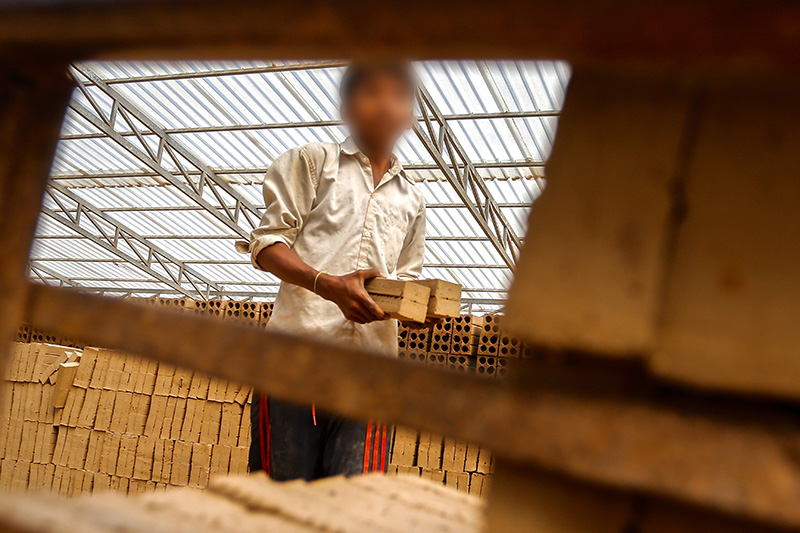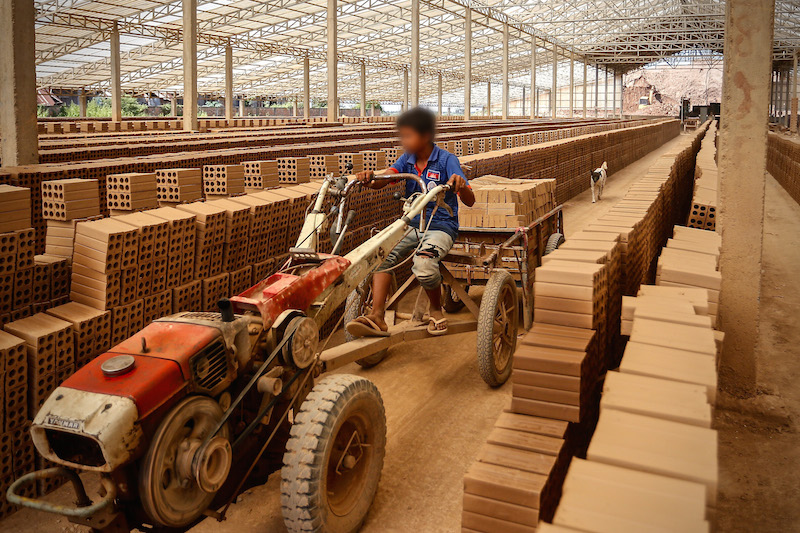Child labor remains common in some brick factories nearly a month after the government announced a crackdown on the practice in the wake of a damning NGO report that says the country’s construction boom was being built on the back of what amounted to modern-day slavery.
Reporters found persistent use of child labor at four factories within an hour’s drive of Phnom Penh in a single day this week—along with unabated debt bondage. Both are illegal under Cambodian law and, in the case of debt bondage, punishable by a stiff prison sentence.

“Built on Slavery,” a report released by local rights group Licadho on December 2, exposed the widespread use of both child labor and debt bondage in the country’s brick factories, unchecked by authorities and trapping whole families in a combination of heavy loans and risky, low-paid piecework that forced them to put their children to work.
From June to August, the NGO visited 11 sites around Phnom Penh that included hundreds of factories with thousands of workers pumping out the millions of cheap bricks feeding the capital’s rapidly rising skyline. Some of the children it found working at the factories were as young as 9 years old.
Within hours of the report’s release, the Labor Ministry put out a statement saying it was taking “urgent action” to investigate the brick factories in every province for children under 15 years old, but made no mention of debt bondage. It faulted Licadho for not reporting its findings before publishing its report.
Two days later, Labor Minister Heng Sour said the inspectors had yet to find a single case of child labor and did not respond to further questions.
Mr. Sour and other ministry officials did not respond to requests for comment on Wednesday, either.
Thun Neang, who heads the labor department in Kandal province, which surrounds Phnom Penh on all sides, said on Wednesday that his staff had inspected about 70 of the more than 100 brick factories in his jurisdiction over the past month. He said they found some factories operating without a license, but declined to reveal whether they had found any child labor because the results were still being compiled.
“The most important thing is we need to push them to implement the law,” he said, declining to say what—if any—penalties lawbreaking owners would face.
Despite a ban on hazardous labor for anyone under 18 years old, Mr. Neang said they were only after factories using children under 15 because older boys and girls were allowed to help their parents. As for the use of debt bondage, he said his department was waiting for instructions from the Labor Ministry on what to do about it.
The province’s deputy police chief for women’s and children’s affairs, Chhim Vanny, also said that her officers only look for children under 15.
“They often go to check, but they have not found any,” she said on Wednesday. “We only consider serious levels of child labor a crime, but the cases we find are only children helping their parents, so how can we ban them?”
The law makes no exception for child labor in the service of a parent.
“When they’re just helping their parents, we just tell them, ‘Please don’t force your kids to work without sending them to school,’” Ms. Vanny said. “If they’re just helping their parents and we consider it a crime, how can they earn enough money to buy food?”
She rejected any responsibility for enforcing the law on debt bondage.

Interior Ministry spokesman Khieu Sopheak, in an interview at his office last week, acknowledged that some brick factories were still trafficking in slave labor. But he also faulted Licadho for not going to authorities with its evidence right away and disputed the NGO’s claims that local authorities are, or should be, well aware of the problems.
“We have more than 60,000 police; how can we understand all phenomena in the country?” he said. “For example, in this room, the police don’t know what we are doing. And there are many secret rooms. For example, I commit a mistake by [receiving] the bribe from you, for example. Who can know? There are many secret places that we cannot access.”
But there is little secret about the factories’ labor abuses.
Reporters had no trouble finding child labor or debt bondage at a number of factories just outside of Phnom Penh.
Reporters found several children 13 years and up at the very first factory they visited a few days before the Licadho report came out in Kandal province. On Tuesday, weeks after the government announced its crackdown, reporters were turned away by owners and foremen at several other factories in Kandal, but found children still working, or parents who said their children still worked, at four other factories.
A 16-year-old boy at one factory in Mok Kampoul district said on Tuesday that he was one of about a half-dozen children under 18 working there, including his 11-year-old brother.
“I take the wood to the kilns. I take the bricks from here to the trucks. I take the dirt to the [brick-making] machine,” said the boy, who declined to give his name for fear of getting in trouble with the factory owner.
“I’m not happy about it, but I’m forced to do it. I want to go to school, but my mom forces me.”
Like every adult the reporters spoke with on both visits to the factories, the boy’s mother owed the factory owner money, about $1,000 in her case.
Debt bondage, in which a person pledges his or her labor as security for a loan owed to a boss, is explicitly listed as a form of labor exploitation under Cambodia’s human trafficking law. It carries a penalty of up to 15 years in prison—20 years if the victim is a minor.
The penalties for child labor go up to 60 days’ pay of the victim. While the labor law allows children to start work at the age of 15, the threshold for hazardous labor is 18. Licadho says it found many cases or reports of serious injury at the factories during its investigation, including children who lost limbs to the brick-making machines.
The boy at the factory in Mok Kampoul said the owners were well aware that his mother was putting him and his brother to work. “They know, but they never warn us,” he said.
The foreman at the factory, who only gave his name as Chamroeun, also out of fear of getting in trouble with his boss, said he had never seen police or labor inspectors visit the facility.
“I have been working here for almost two years, but I have not seen any officials come here,” he said.

At another factory in the same district, the foreman said two of his own daughters, aged 8 and 10, helped him most days after school, loading carts with bricks, pushing the loaded carts and packing the kilns.
But he said the girls were in no danger because he made sure to keep them away from the brick-making machine.
“I don’t force them, but when they see me work they come to help,” he said. As for the police, he said, they “often come and look around, and then they go.”
Owners, foremen and workers at many of the factories visited on Tuesday said police and labor inspectors had paid a visit since the Licadho report came out, warning them not to use children. But none reported any fines, let alone arrests, or any mention whatsoever of debt bondage.
A woman at a brick factory in Khsach Kandal district, who owed her boss about $2,000, said she stopped putting her 14- and 15-year-old girls to work every day after a visit from Licadho staff a few months ago. But because staff at public schools that should be free of charge demand daily fees from their students, she still can’t afford to send her daughters to class.
“They [Licadho] said it was illegal, so I decided to stop. But my boss never cared about it,” the woman said. “I still use them sometimes when I am sick, but not often.”
With the piecework earning her only about $2.50 a day, she said, “If I can’t put them to work, we won’t have money to eat.”
Naly Pilorge, Licadho’s deputy director of advocacy, said child labor and debt bondage at the factories would continue to flourish as long as there was no prosecutions or punishment.
But she said putting the factories out of business could make life even harder for their employees by putting them out of work and possibly into even more dangerous jobs. So the NGO is recommending a one-time amnesty for factory owners who agree to forgive their employees’ debts.
“This recognizes the wrongdoing, but allows the workers to keep their jobs in improved conditions,” Ms. Pilorge said.
Licadho is also recommending reforming the labor inspection system so that officials do their jobs and focus on dangerous work sites such as the brick factories first; outlawing piecework in the brick-making industry and guaranteeing a minimum wage; and raising the salaries of local authorities so they are less tempted to take bribes in exchange for turning a blind eye.
But Ms. Pilorge said a lasting fix was almost impossible if the government continued to ignore the debt bondage the workers were trapped in.
“The current system of debt bondage combined with payment of a very low piece rate makes child labor pretty much inevitable as the workers simply can’t live on the money they make, let alone afford to send their children to school,” she said.
Owing money to the same people their jobs depend on also leaves the workers unlikely to complain about abuse or ask for better conditions.
“Until the workers are able to make and keep a wage they can live on,” Ms. Pilorge said, “they will continue to be forced to rely on the work of their children to help support the family.”
(Additional reporting by Colin Meyn)



